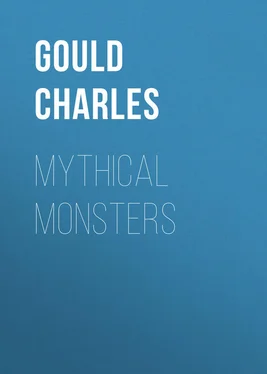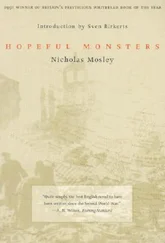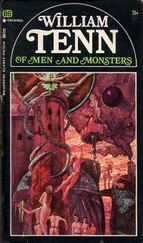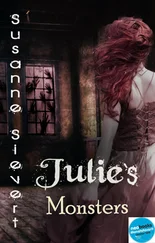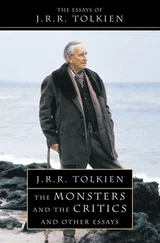Charles Gould - Mythical Monsters
Здесь есть возможность читать онлайн «Charles Gould - Mythical Monsters» — ознакомительный отрывок электронной книги совершенно бесплатно, а после прочтения отрывка купить полную версию. В некоторых случаях можно слушать аудио, скачать через торрент в формате fb2 и присутствует краткое содержание. Жанр: Мифы. Легенды. Эпос, Природа и животные, foreign_antique, foreign_prose, на английском языке. Описание произведения, (предисловие) а так же отзывы посетителей доступны на портале библиотеки ЛибКат.
- Название:Mythical Monsters
- Автор:
- Жанр:
- Год:неизвестен
- ISBN:нет данных
- Рейтинг книги:5 / 5. Голосов: 1
-
Избранное:Добавить в избранное
- Отзывы:
-
Ваша оценка:
- 100
- 1
- 2
- 3
- 4
- 5
Mythical Monsters: краткое содержание, описание и аннотация
Предлагаем к чтению аннотацию, описание, краткое содержание или предисловие (зависит от того, что написал сам автор книги «Mythical Monsters»). Если вы не нашли необходимую информацию о книге — напишите в комментариях, мы постараемся отыскать её.
Mythical Monsters — читать онлайн ознакомительный отрывок
Ниже представлен текст книги, разбитый по страницам. Система сохранения места последней прочитанной страницы, позволяет с удобством читать онлайн бесплатно книгу «Mythical Monsters», без необходимости каждый раз заново искать на чём Вы остановились. Поставьте закладку, и сможете в любой момент перейти на страницу, на которой закончили чтение.
Интервал:
Закладка:
Конец ознакомительного фрагмента.
Текст предоставлен ООО «ЛитРес».
Прочитайте эту книгу целиком, купив полную легальную версию на ЛитРес.
Безопасно оплатить книгу можно банковской картой Visa, MasterCard, Maestro, со счета мобильного телефона, с платежного терминала, в салоне МТС или Связной, через PayPal, WebMoney, Яндекс.Деньги, QIWI Кошелек, бонусными картами или другим удобным Вам способом.
1
This tributary offering is a common feature in dragon legends. A good example is that given by El Edrisi in his history of the dragon destroyed by Alexander the Great in the island of Mostachin (one of the Canaries?).
2
The latest writer on this point summarizes his views, in his opening remarks, as follows: – “The science of heraldry has faithfully preserved to modern times various phases of some of those remarkable legends which, based upon a study of natural phenomena, exhibit the process whereby the greater part of mythology has come into existence. Thus we find the solar gryphon, the solar phœnix, a demi-eagle displayed issuing from flames of fire; the solar lion and the lunar unicorn, which two latter noble creatures now harmoniously support the royal arms. I propose in the following pages to examine the myth of the unicorn, the wild, white, fierce, chaste, moon, whose two horns, unlike those of mortal creatures, are indissolubly twisted into one; the creature that endlessly fights with the lion to gain the crown or summit of heaven, which neither may retain, and whose brilliant horn drives away the darkness and evil of the night even as we find in the myth, that Venym is defended by the horn of the unicorn.” — The Unicorn; a Mythological Investigation. Robert Brown, jun., F.S.A. London, 1881.
3
“The midgard or world-serpent we have already become tolerably well acquainted with, and recognise in him the wild tumultuous sea. Thor contended with him; he got him on his hook, but did not succeed in killing him. We also remember how Thor tried to lift him in the form of a cat. The North abounds in stories about the sea-serpent, which are nothing but variations of the original myths of the Eddas. Odin cast him into the sea, where he shall remain until he is conquered by Thor in Ragnarok.” — Norse Mythology , p. 387. R. B. Anderson, Chicago, 1879.
4
Vide Anderson.
5
Just as even the greatest masters of fiction adapt but do not originate. Harold Skimpole and Wilkins Micawber sat unconsciously for their portraits in real life, and the most charming characters and fertile plots produced by that most prolific of all writers, A. Dumas, are mere elaborations of people and incidents with which historical memoirs provided him.
6
Atlantis; the Antediluvian World. J. Donelly, New York, 1882. The author has amassed, with untiring labour, a large amount of evidence to prove that the island of Atlantis, in place of being a myth or fable of Plato, really once existed; was the source of all modern arts and civilization; and was destroyed in a catastrophe which he identifies with the Biblical Deluge.
7
So also, Father Stanislaus Arlet, of the Society of Jesus, writing to the General of the Society in 1698 respecting a new Mission in Peru, and speaking of a Peruvian tribe calling themselves Canisian, says: “Having never before seen horses, or men resembling us in colour and dress, the astonishment they showed at our first appearance among them was a very pleasing spectacle to us, the sight of us terrifying them to such a degree that the bows and arrows fell from their hand; imagining, as they afterwards owned, that the man, his hat, his clothes, and the horse he rode upon, composed but one animal.”
8
The Voyages and Adventures of Ferdinand Mendez Pinto , done into English by H. C. Gent, London, 1653, p. 109. The vindication of Pinto’s reputation for veracity will doubtless one day be, to a great extent, effected, for although his interesting narrative is undoubtedly embroidered with a rich tissue of falsity, due apparently to an exaggerated credulity upon his part, and systematic deception upon that of his Chinese informants, he certainly is undeserving of the wholesale condemnation of which Congreve was the reflex when he made Foresight, addressing Sir Sampson Legend, say: “Thou modern Mandeville, Ferdinand Mendez Pinto was but a type of thee, thou liar of the first magnitude.” — Love for Love , Act. 2, Scene 1. There are many points in his narrative which are corroborated by history and the accounts of other voyages; and it must be remembered that, although the major part of the names of places and persons which he gives are now unrecognisable, yet this may be due to alterations from the lapse of time, and from the difficulty of recognising the true original Chinese or Japanese word under those produced by the foreign mode of transliteration in vogue in those days. Thus the Port Liampoo of Pinto is now and has been for many years past only known as Ningpo, the first name being a term of convenience, used by the early Portuguese voyagers, and long since abandoned. Just as the wonderful Quinsay of Marco Polo (still known by that name in Pinto’s time) has been only successfully identified (with Hangchow-fu) through the antiquarian research of Colonel Yule. So also the titles of Chaems, Tutons, Chumbins, Aytons, Anchacy’s, which Pinto refers to (p. 108), are only with difficulty recognisable in those respectively of Tsi‘ang (a Manchu governor), Tu-tung (Lieutenant-General), Tsung-ping (Brigadier-General), Tao-tai [??] (Intendant of Circuit) and Ngan-ch‘a She-sze (Provincial Judge), as rendered by the modern sinologue Mayers in his Essay on the Chinese Government, Shanghai, 1878. The incidental references to the country, people, habits, and products, contained in the chapter describing his passage in captivity from Nanquin to Pequin are true to nature, and the apparently obviously untruthful statement which he makes of the employment by the King of Tartary of thousands of rhinoceri both as beasts of burthen and articles of food (p. 158) is explicable, I think, on the supposition that some confusion has arisen, either in translation or transcription, between rhinoceros and camel. Anyone who has seen the long strings of camels wending their way to Pekin from the various northern roads through the passes into Mongolia, would readily believe that a large transport corps of them could easily be amassed by a despotic monarch; while the vast numbers of troops to which Pinto makes reference are confirmed by more or less authentic histories.
9
“I was myself an eye-witness of two such discoveries and helped to gather the articles together. The slanderers have long since been silenced, who were not ashamed to charge the discoverer with an imposture.” – Prof. Virchow, in Appendix I. to Schliemann’s Ilios . Murray, 1880.
10
“But ask them to credit an electric telegram, to understand a steam-engine, to acknowledge the microscopic revelations spread out before their eyes, to put faith in the Atlantic cable or the East India House, and they will tell you that you are a barbarian with blue eyes, a fan kwai, and a sayer of that which is not. The dragon and the phœnix are true, but the rotifer and the message, the sixty miles an hour, the cable, and the captive kings are false.” — Household Words , October 30th, 1855.
Читать дальшеИнтервал:
Закладка:
Похожие книги на «Mythical Monsters»
Представляем Вашему вниманию похожие книги на «Mythical Monsters» списком для выбора. Мы отобрали схожую по названию и смыслу литературу в надежде предоставить читателям больше вариантов отыскать новые, интересные, ещё непрочитанные произведения.
Обсуждение, отзывы о книге «Mythical Monsters» и просто собственные мнения читателей. Оставьте ваши комментарии, напишите, что Вы думаете о произведении, его смысле или главных героях. Укажите что конкретно понравилось, а что нет, и почему Вы так считаете.
